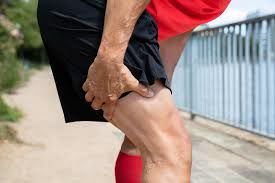What is a hamstring strain?
Hamstring tears are one of the most common sporting injuries that occur where the muscle fibres in the back of your thigh are damaged when overstretched or overloaded. Although these injuries are common to sports, they are not exclusive to them.
Anatomy
The hamstrings are a group of 3 major muscles on the back of your thigh that are responsible for the bending (flexing) of your knee, and the straightening (extending) of your hip. Your hamstrings play a vital role in running, jumping and protecting your knee.
How do they happen?
Hamstring strains normally happen in two ways:
- Sprinting: Rapid contraction of the muscle fibres
- Overstretching: uncontrolled, rapid or overloaded lengthening of muscles fibres
Symptoms
Hamstring strains graded from 1-3 based on their severity, with grade 3 being the worst. Symptoms vary depending on severity of injury, however their presentations are fairly similar. People report a:
- Sudden sharp, grabbing or popping pain in the back of their thigh, followed by decreased strength and function.
- Gradual ‘tightness’ or aching in the back of the leg, followed by weakness, during or after activity.
- ‘Overstretched’ feeling in their leg.
Prevention
Hamstring injury prevention involves more than just stretching and light exercise before activity. Preventing hamstring strains are a complex process that is different for everyone, and includes a combination of mobility, strength and conditioning exercises. These exercises need to be specific to the activities or sports you engage in. To better understand and prevent these injuries, it is best to consult with your physiotherapist.
Diagnosis
When diagnosing a hamstring strain, you may experience several symptoms including:
- Pain on walking, sitting or straightening leg
- Hard to actively bend your knee
- Bruising & swelling: this can come up behind your knee
- Weakness: can be hard to actively bend knee
To achieve a correct diagnosis, your physio can assess your injury to determine the severity, rule out neural (nerve) injury/involvement, providing you with advice on your rehabilitation timeframes and plan for return to normal activity. Further investigations may also be needed such as ultrasound or MRI, or referral to sports physicians for higher grade injuries.
Immediate Management
For any acute soft tissue injury, the first 48-72 hours is about managing pain, swelling and protecting the injured area. Commonly used is the RICER (rest, ice, compress, elevate, referral).
The more modern POLICE is particularly relevant with hamstring injuries. The injured area should be:
- Protected
- Optimally Loaded: the right amount of activity can help with swelling and soft tissue healing.
- Iced
- Compressed
- Elevated
Healing Time & Prognosis
Hamstring strains take time to rehabilitate, and vary depending on severity. Regardless of the severity, strengthening, conditioning and mobility exercises are crucial to rehabilitation.
- Grade 1:Less than 25% of the muscle fibres are torn during the injury. For most individuals, this injury resolves in 2-4 weeks with appropriate rehabilitation and ongoing strengthening.
- Grade 2:Between 25%-90% of torn muscle fibres, often associated with noticeable limping, bruising and swelling behind the knee. Normally between 4-12 weeks for return to sport.
- Grade 3:A grade 3 injury is when > 90% of the fibres have torn and can include a complete rupture of the muscle. These injuries can be quite painful, and can be quite debilitating, often where crutches are needed to assist with walking. Where the muscle is completely ruptured, surgery (is generally) may be required. A grade 3 injury can take 3-12 months to return to sport.
Physiotherapy Management
Hamstring injuries are complex, and require an individualized rehabilitation program. Premature return to sport and poor rehabilitation regularly leads to re-injury, with up to 1 in 3 strains reoccurring within 1 year of the initial injury. People regularly report reduced strength, speed, endurance or mobility several months post injury.
After the acute phase of injury, promotion of active range of motion, improving general mobility and weightbearing, and starting muscle strengthening are the primary goals of treatment. Dynamic or powerful activities, like sprinting, jumping, twisting or sudden change of direction movements are limited initially due to the risk of re-injury.
Your physio will help guide you through your rehab process, progressing your program through a series of milestones to get you back to being stronger than you were before your injury, and provide you with strategies/program(s) to prevent these injuries from reoccurring in the future.

